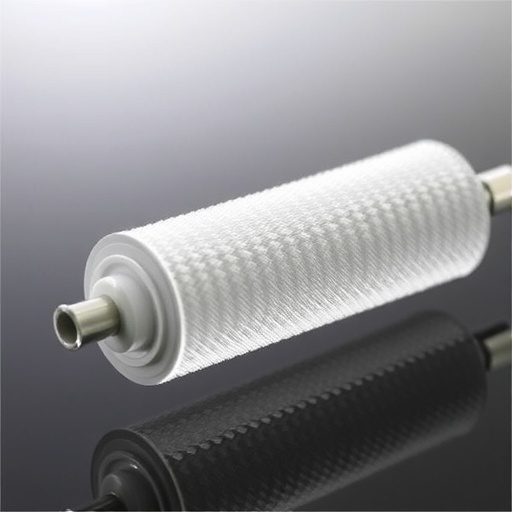In the quest for sustainable solutions to pressing environmental issues, a remarkable development has emerged in the field of ion exchange membranes. Researchers led by Hamidi, Javadi, and Hosseini have pioneered an innovative PVC/Fe(OH)₃ ion exchange membrane specifically designed for the efficient removal of arsenic from contaminated water. This groundbreaking study, set for release in the prestigious journal Ionics in 2025, unveils not only the synthesis of these membranes but also their performance characteristics and pH-dependent behavior, marking a significant advancement in water purification technology.
Arsenic contamination in drinking water remains a critical global health concern, with millions of people exposed to unsafe levels of this toxic element. Through their research, the team has focused on developing a membrane that not only enhances arsenic removal but also operates effectively under varying pH conditions, thus addressing one of the major challenges in conventional water treatment methods. The synthesis of the PVC/Fe(OH)₃ ion exchange membrane involved meticulous experimentation, where the researchers successfully integrated ferrous hydroxide into polyvinyl chloride matrices, creating a composite structure that optimally combines structural integrity with ion exchange capacity.
The use of PVC as a matrix material provides significant advantages, as it is both cost-effective and widely available. However, the integration of Fe(OH)₃ transforms the membrane by harnessing the unique properties of iron hydroxide, known for its high adsorption capabilities. This innovative approach not only enhances the membrane’s efficacy in removing arsenic but also ensures durability and resilience against degradation commonly associated with traditional ion exchange membranes.
One of the standout features of the PVC/Fe(OH)₃ membrane is its impressive performance across a range of pH levels. Conventional membranes often struggle under varying acidity or alkalinity, which can drastically alter their effectiveness. However, this new membrane was specifically designed to maintain optimal performance even when exposed to fluctuating pH conditions. This adaptability makes it particularly suitable for real-world applications, where the chemical composition of water can change due to natural or anthropogenic factors.
Testing protocols involved rigorous experimental conditions to ascertain the membrane’s performance in arsenic ion removal. The researchers conducted a series of batch and continuous-flow tests, meticulously documenting the membrane’s efficiency in capturing arsenic ions from water. The outcomes revealed an astonishing reduction in arsenic concentration, highlighting the membrane’s potential as a robust solution for water purification. Furthermore, the synthesis process was optimized to ensure scalability, promising an accessible pathway for large-scale production.
As the research progresses, attention is also drawn to the potential implications for public health and environmental sustainability. The successful deployment of this PVC/Fe(OH)₃ ion exchange membrane in regions plagued by arsenic contamination could help alleviate the dire consequences associated with exposure to this harmful element. From Bangladesh to parts of the United States, communities can benefit from reliable, efficient water treatment solutions that significantly reduce arsenic levels in drinking water.
Additionally, the study reveals noteworthy insights into the mechanisms at play during ion exchange processes. The interaction between PVC and Fe(OH)₃ facilitates not only the physical adsorption of arsenic but also engages in chemical interactions, effectively binding the toxic ions and rendering them immobile in the treated water. This dual-action mechanism underscores the sophistication of the membrane’s design, which reflects a deep understanding of materials science and environmental chemistry.
A pivotal aspect of the research lies in its commitment to sustainability. By utilizing environmentally benign materials in the membrane’s composition, the team emphasizes the need for green chemistry principles in addressing environmental challenges. The PVC blend minimizes reliance on hazardous substances while maximizing functional performance, setting a new standard for future developments in water treatment technologies.
Moreover, the team’s innovative approach raises questions about the potential for further enhancements. Future research could explore the incorporation of additional materials or modifications to the current composition, possibly leading to even greater efficiencies in arsenic removal or the ability to target other contaminants present in polluted water sources. Each iteration of the membrane will contribute valuable lessons and insights into the complex interactions between materials and pollutants.
The implications of this work extend beyond technological innovation. This research serves as a beacon of hope, illustrating that with creative thinking and scientific research, the most dire environmental threats can be addressed. As public awareness of water quality issues continues to grow, the demand for effective purification technologies will rise, creating opportunities for industries to invest in advanced solutions.
As the findings progress toward publication, the scientific community eagerly anticipates not only the results but also the methodology that could be replicated in other regions facing similar challenges. The PVC/Fe(OH)₃ ion exchange membrane stands at the forefront of innovation, offering a glimpse into a future where access to clean drinking water may no longer be a privilege but a fundamental right for all.
In summary, the synthesis and testing of the PVC/Fe(OH)₃ ion exchange membrane represent a significant leap forward in the field of water purification. With its impressive arsenic removal capabilities, adaptability to various pH conditions, and commitment to sustainability, this research promises to pave the way for effective solutions to one of the world’s most pressing environmental issues. As communities worldwide grapple with the health consequences of arsenic exposure, this innovative technology holds the potential to transform water treatment practices and ensure access to safe drinking water for generations to come.
Subject of Research: PVC/Fe(OH)₃ ion exchange membranes for arsenic removal
Article Title: Innovative PVC/Fe(OH)₃ ion exchange membranes for efficient arsenic removal: synthesis, performance, and pH-dependent behavior
Article References: Hamidi, A., Javadi, A., Hosseini, S.M. et al. Innovative PVC/Fe(OH)3 ion exchange membranes for efficient arsenic removal: synthesis, performance, and pH-dependent behavior. Ionics (2025). https://doi.org/10.1007/s11581-025-06677-4
Image Credits: AI Generated
DOI: https://doi.org/10.1007/s11581-025-06677-4
Keywords: ion exchange membranes, arsenic removal, PVC, Fe(OH)₃, water purification, environmental sustainability.




